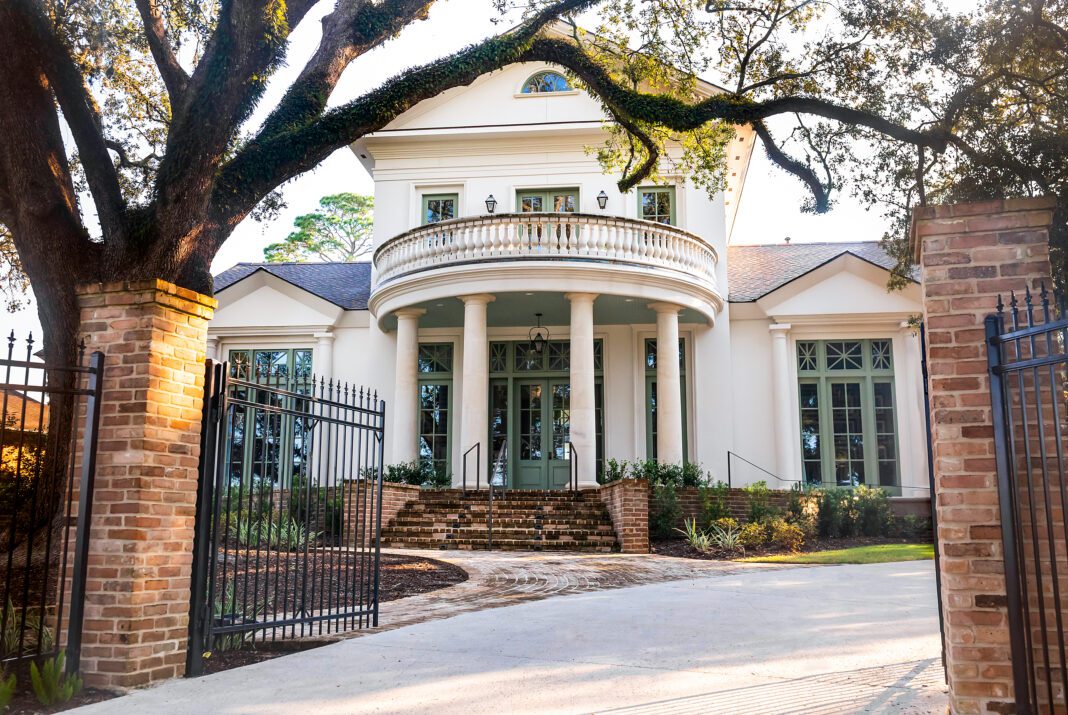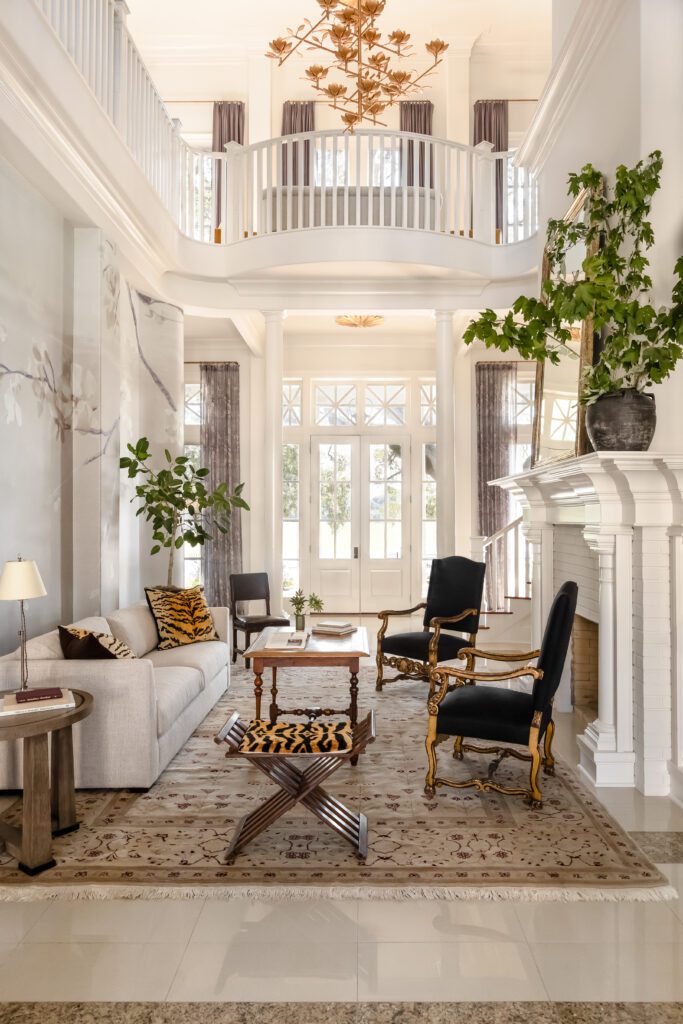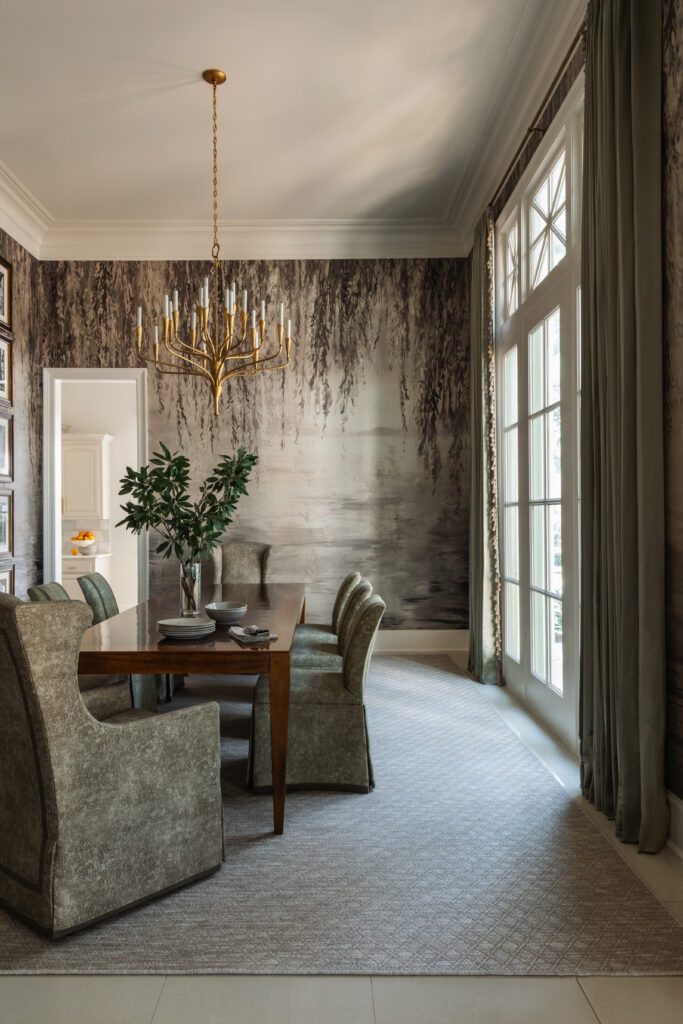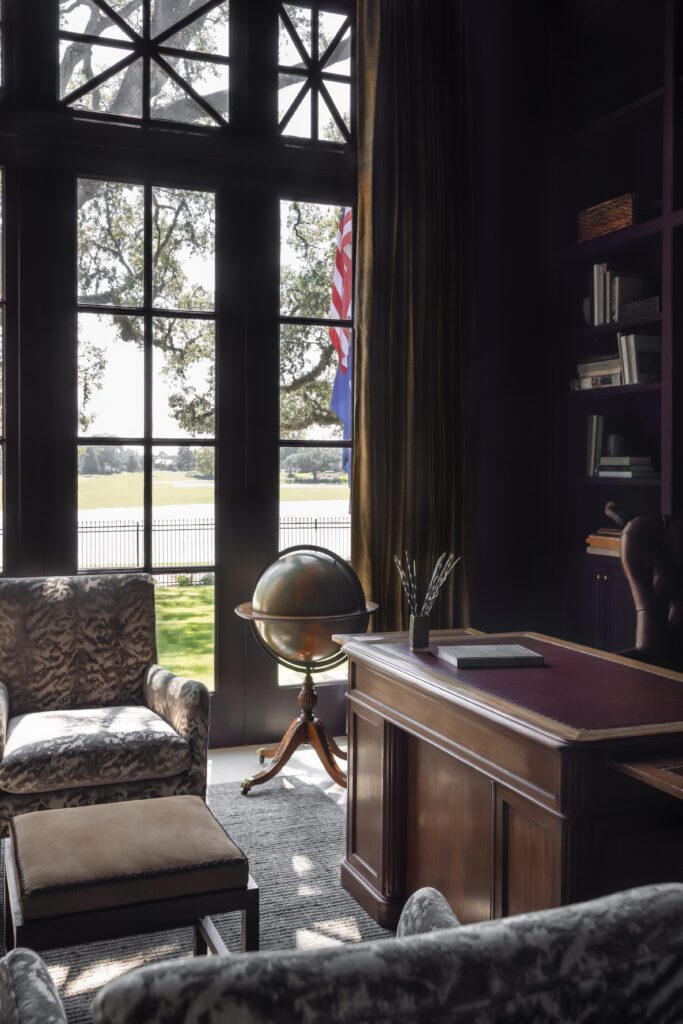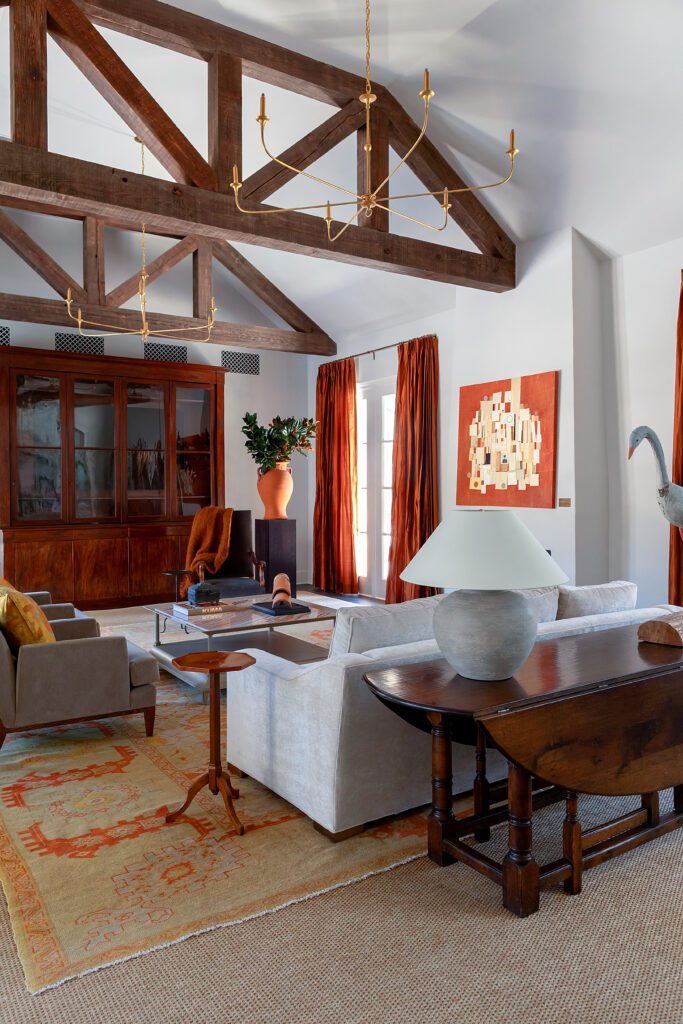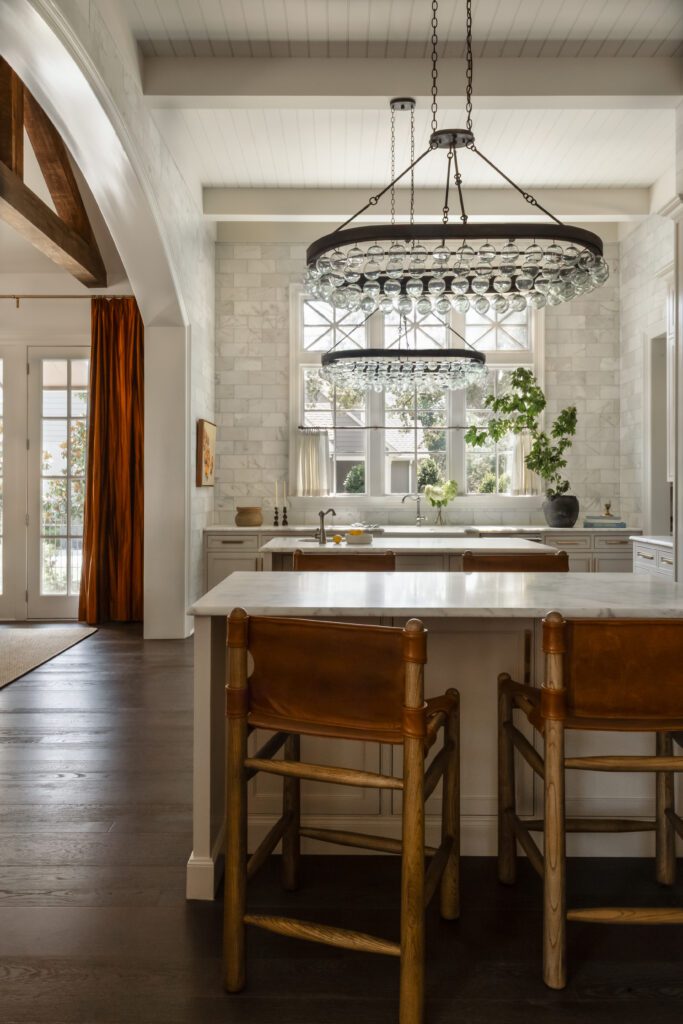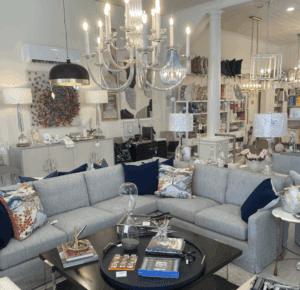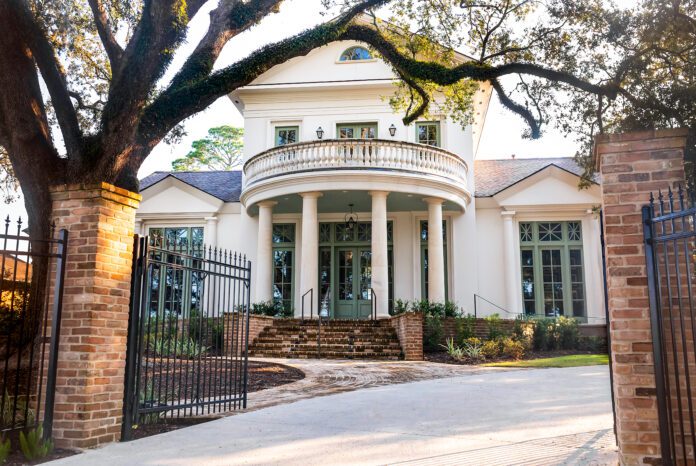An inside look at LSU’s new University House
To find inspiration for his interior design of LSU’s latest University House, Kenneth Brown had to put down his pencil and put on his sneakers.
“When I finally said yes to this project, I just walked the lakes,” says Brown, an LSU alumnus whose design portfolio includes high-profile jobs both in Hollywood and here in his Baton Rouge hometown. “I walked the campus. I was moved and influenced by the history of the oak trees. I was mesmerized by the story of the clay tile that is everywhere. And the more I did that, the more my design concept started falling into place.”
The results of Brown’s interior vision now form the backdrop of a key venue for university fundraising and official festivities. This version of the University House on South Lakeshore Drive, which is intended for use as a home for the school’s president as well as a location for entertaining important guests, takes the place of the midcentury home on East Lakeshore Drive that previously served as the official residence of the LSU president.

The LSU Foundation purchased the 7,600-square-foot South Lakeshore Drive home in the fall of 2023 after it became evident that the previous home was no longer suitable, says Foundation CEO Robert Stuart Jr. “The house is in a significant state of disrepair and has been for quite a while,” Stuart says. “But also, and more importantly, as we looked around the SEC, nearly every peer university has a significant house usually on or near the campus for the president or the chancellor, and it’s part personal residence and part place where you can entertain donors, entertain legislators, and otherwise work on the development of the organization.”
As Stuart notes, one of a university president’s major duties is to “make sure you have the resources to run the university,” especially when faced with falling state appropriations. A home like this one, which Stuart says is common at public and private institutions around the country, facilitates interactions with current and potential donors in an intimate setting, laying the groundwork for meaningful investments that help the campus continue to thrive.
When searching for a home that could become the new University House, location was key. “We decided the lakes were the right place to be,” Stuart says, noting their proximity and connection to campus. He adds that the property’s position in the Magnolia Ridge neighborhood up that it had access to a central alley with ample shared space for parking—ideal for just the sort of large gatherings the house would host. “One of the potential drawbacks of the lakes is the lack of parking, but this one was really ideal.”
As owner of the house, the Foundation spearheaded the necessary renovations to get it ready for its new function. Throughout the process, leaders were intentional about engaging design professionals and artists with strong connections to LSU. In addition to asking Kenneth Brown to take on the interiors, they partnered with Bill Reich, son of LSU School of Landscape Architecture namesake Robert Reich, to reimagine the landscape surrounding the house. LSU Facility Services employees assisted with the construction of cabinetry and many other tasks along the way.
Brown’s passion for this project came in part from this being an opportunity for him to leave his own legacy at LSU. “The beauty of LSU is the community, so the sense of place had to be first and foremost,” he says. “As a designer, we create those stories and we create an interior experience. So I hit the ground running.”
Instead of splashing the walls and furnishings with vibrant purple and gold, Brown chose to form deeper visual connections to the school. The story begins in the large central entry hall and living area, where a 22-foot-high wall makes a statement in an overscale magnolia motif. “With this very grand-scale room, we wanted something that really sort of set the stage for what you were going to see when you entered the dining hall,” he says.
The abundant trees on and related to LSU’s campus inspired the design of the adjacent dining area, which features a showstopping gallery wall of black-and-white photographs of sturdy oaks and swaying cypresses. The photos were taken by local attorney and LSU alumnus Randy Roussel, who has published several books of his south Louisiana nature photography. Nods to the local landscape permeate this space, from the wallpaper to the upholstered chairs to the draperies trimmed with moss-like baubles.
Beyond the kitchen, which required only minimal renovation, the large-scale family room is another key area for entertaining. Here, Brown was inspired by the color of the terracotta roof tiles atop campus buildings. “The Olmsted brothers, inspired by San Giorgio dei Greci in Venice, Italy, wanted to bring the Italian Renaissance to the Bayou State,” reads a plaque that sits on a table beside an example of those tiles. “The rich terracotta roofs have glistened in the southern Louisiana sun since 1926.”
Here and in several other rooms throughout the house are antique furnishings that Brown sourced with help from Laura Roland at Fireside Antiques. Other local vendors and artisans who contributed to the design project include furniture restorers Randy Messina and Gregory Dunbar, custom upholsterer Debra Miley, photographer David Humphreys, Daryl & Sons Framing, Dixon Smith Interiors, McMillin Interiors, drapery fabricator Andy Plaisance, and Ann Connelly Fine Art, which helped place key artwork by prominent members of the LSU art community.
Former LSU president William Tate and his wife Kim moved into the house in November 2024 after work on its public and private spaces was complete. After the Tates left LSU in June of this year, interim LSU President Matt Lee became the de facto host of gatherings here, though he does not reside in the home.
“This is the perfect home to entertain the kind of constituents that LSU and the LSU Office of the President have,” Lee says. “We’re just delighted that we get the chance to make use of this investment in the university.”
The home’s social calendar is packed many months out. Recent events have included a 50-person seated dinner, a breakfast meeting, and a luncheon for an LSU Foundation Board of Directors member who received an honorary degree. For a dinner held in conjunction with Louisiana Farm Bureau, the menu included biscuits made with LSU-grown sweet potatoes and a sweet potato cheesecake for dessert. After all, LSU boasts the only research center in the country devoted exclusively to sweet potatoes, officials are proud to point out.
In coming months, the home will play host to donors, visiting dignitaries, and faculty and staff members for small- and large-scale recognition events. “It’s a tremendous opportunity for the president to host influential donors in a very comfortable setting,” Stuart says. “Certainly, we’re here at the Foundation to support the development effort, but the president of the university really is the key development person in terms of the bigger donors who really want to hear his vision and his ideas.”
Lee says the events held at the University House are also an extension of the way students are welcomed onto campus. “I always say LSU is like a house with a wrap-around porch,” he says. “People call athletics LSU’s front porch, but academics is another porch. Research is another porch. And the AgCenter is another porch. We have all these things we do that serve to bring in key constituents to our base, and this house is where it all comes together.




